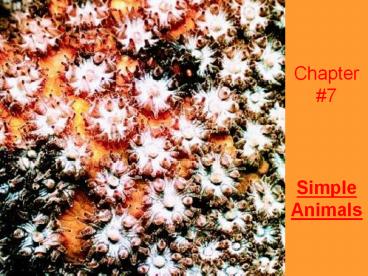Simple Animals - PowerPoint PPT Presentation
1 / 19
Title:
Simple Animals
Description:
Chapter #7 Simple Animals Chapter 7.1 Notes Traits of Animals Animals can not make food Most animals can move from place to place. Animals have many cells. – PowerPoint PPT presentation
Number of Views:105
Avg rating:3.0/5.0
Title: Simple Animals
1
Chapter 7 Simple Animals
2
Chapter 7.1 Notes
- Traits of Animals
- Animals can not make food
- Most animals can move from place to place.
- Animals have many cells. The cells make up
tissues and organs that form systems. - Most animals have symmetry.
3
- Symmetry
- Radial- around a circle
- Bilateral- cut into two halves.
Bilateral Symmetry
Radial Symmetry
4
- Vertebrates- animals with a backbone.
- Invertebrates- animals without a backbone.
5
- Animal Phyla (Phylums)
- Stinging-cell
- Soft-bodies
- Spiny-skin
- Chordates- the most complex
- Jointed-leg
- Sponges
- Worms
6
Chapter 7.2 Notes
- Sponges-simple invertebrates that have pores.
- Do NOT move about freely.
- Live attached to rocks
- Water enters through pores and leaves through an
opening - Filter Feeders
- 2 cell layers thick. No tissue or organs.
- Have 3 cell types
- Trap food
- Cover and protect
- Make skeleton
- Reproduce sexually and asexually.
7
- Stinging-cell animals- have hollow saclike bodies
that lack organs. - Nematocysts- stinging cells
- Tentacles- arm like parts
- Radial symmetry
- 2 cell layers
- One opening called a mouth
- Disc- structure they fasten to the bottom of
ocean or rocks. - Have muscle and nerve cells
- Most reproduce sexually
8
Jelly Fish
Coral
Sea Anemone
Stinging cell Animals
9
Chapter 7.3 Notes
- 3 phyla of worms
- Flatworms- the simplest worms. Examples Tapeworm
(parasite) and planarian (Free-living). - Roundworms- example hookworms (parasite).
- Segmented worms- most complex worms. Examples
earthworm (Free-living) and leeches (parasite).
10
- Life Cycle of a Tapeworm
- Pig or cows eat tapeworm eggs
- Eggs hatch in pigs/cows intestine
- Tapeworm enter blood stream
- Form cysts
- People eat undercooked meat
- Tapeworms get in their intestine and grow
- Body sections break off and leave the hosts body
in solid waste.
11
Life Cycle of the Tapeworm
12
Tapeworm
13
Chapter 7.4 Notes
- Soft-bodied animals (Mollusc)- are animals with a
soft body that usually have a shell inside or
outside. - Are invertebrates (no backbone).
- The body is covered by a thin, fleshy tissue
called a mantle. - Soft-bodied animals have a muscular foot for
moving from place to place.
14
- 3 classes of soft-bodied animals (Mollusc)
- Gastropods- snails and slugs. Have wide muscular
foot. Have single shell or no shell. - Bivalves- clams, oysters, and scallops. Have 2
shells. - Cephalopods-octopus, squid, and cuttlefish.
Squids and cuttlefish ave shells inside their
bodies, octopus no shell.
15
SLUG
Snail
Octopus
16
Drawing Rules
- Use white paperno lines.
- Do NOT fold paper
- Put a title on your paper (Earthworm)
- Name, date, hour
- Label all parts
- Straight lines when labeling parts.
- Color
- Use a full sheetdraw big
17
Worked Cited
- simple Animals. March 23, 2007.
http//www.earthseaspacemuseum.org/img/activities_
ocean_img/sea_sponge.jpg - Coral. March 23, 2007. http//www.waterencyclope
dia.com/images/wsci_01_img0119.jpg - Radial Symmetry. March 23, 2007.
http//www.geocities.com/Omegaman_UK/symmetry/SNFL
AKE.gif - Bilateral Symmetry. March 23, 2007.
http//teacher.scholastic.com/lessonrepro/lessonpl
ans/profbooks/images/hearts.gif
18
- Vertebrates. March 23, 2007. http//www.edsci-af
filiates.com/images/vertebrates_divider.jpg - 5 kingdoms. March 23, 2007. http//www.sciencecl
arified.com/images/uesc_06_img0326.jpg - Sea Anemone March 26, 2007. http//www.britannic
a.com/ebi/article-9276965 - Jelly Fish. March 26, 2007. http//www.gomanzani
llo.com/scubamex/1jelly.jpg - Sun Coral. March 26, 2007. http//www.melevsreef
.com/pics/0604/sun_coral_914pm.jpg - Tapeworm Lifecycle. March 27, 2007.
http//www.scientific-art.com/GIF20files/Medical/
tapeworm.gif - Tapeworm. March 27, 2007. http//www.corkscrew-b
alloon.com/03/11/2lon/img/26a1.jpg
19
- Snail. March 28, 2007. http//www.worth1000.com/
web/media/312375/Snails.jpg - Slug. March 28, 2007. http//www.uidaho.edu/so-i
d/entomology/Home__Garden/garden20slug.jpg - Internal clam. March 28, 2007.
http//www.bio200.buffalo.edu/labs/images/clam.JPG
- Octopus. March 28, 2007. http//www.glaucus.org.
uk/Octopus-RY.jpg































